Casio Radio Controled WVA-M650TD-1AER Handleiding
Bekijk gratis de handleiding van Casio Radio Controled WVA-M650TD-1AER (9 pagina’s), behorend tot de categorie Horloge. Deze gids werd als nuttig beoordeeld door 458 mensen en kreeg gemiddeld 4.5 sterren uit 229.5 reviews. Heb je een vraag over Casio Radio Controled WVA-M650TD-1AER of wil je andere gebruikers van dit product iets vragen? Stel een vraag
Pagina 1/9

Operation Guide 5110
MO1408-EA © 2014 CASIO COMPUTER CO., LTD.
E-1
Getting Acquainted
Congratulations upon your selection of this CASIO watch. To get the most out of your
purchase, be sure to read this manual carefully.
Keep the watch exposed to bright light
The electricity generated by the solar panel of the watch is
stored by a built-in battery. Leaving or using the watch
where it is not exposed to light causes the battery to run
down. Make sure the watch is exposed to light as much
as possible.
• When you are not wearing the watch on your wrist,
position the face so it is pointed at a source of bright
light.
• You should try to keep the watch outside of your sleeve
as much as possible. Charging is reduced signifi cantly
if the face is even only partially covered.
Bright Light
Solar panel
E-2
• The watch continues to operate, even when it is not exposed to light. Leaving the
watch in the dark can cause the battery to run down, which will result in some
watch functions to be disabled. If the battery goes dead, you will have to
re-confi gure watch settings after recharging. To ensure normal watch operation, be
sure to keep it exposed to light as much as possible.
All
functions
enabled
LEVEL 1
LEVEL 2
LEVEL 3
LEVEL 4
Charge
Rechargeable battery
Bright Light
Battery charges in the light.
Electrical
energy
Solar panel
(Converts light to
electrical power.)
Some or all
functions
disabled
LEVEL 1
LEVEL 2
LEVEL 3
LEVEL 4
Dis-
charge
Battery discharges in the dark.
E-3
• The actual level at which some functions are disabled depends on the watch
model.
• Frequent display illumination can run down the battery quickly and require
charging. The following guidelines give an idea of the charging time required to
recover from a single illumination operation.
Approximately 5 minutes exposure to bright sunlight coming in through a window
Approximately about 8 hours exposure to indoor fl uorescent lighting
• Be sure to read “Power Supply” (page E-49) for important information you
need to know when exposing the watch to bright light.
If the display of the watch is blank...
If the display of the watch is blank, it means that the watch’s Power Saving function
has turned off the display to conserve power.
• See “Power Saving Function” (page E-66) for more information.
Note that CASIO COMPUTER CO., LTD. assumes no responsibility for any
damage or loss suffered by you or any third party arising through the use of your
watch or its malfunction.
E-4
About This Manual
• Depending on the model of your watch, display text
appears either as dark fi gures on a light background
or light fi gures on a dark background. All sample
displays in this manual are shown using dark fi gures
on a light background.
• Button operations are indicated using the letters
shown in the illustration.
• Each section of this manual provides you with the
information you need to perform operations in each
mode. Further details and technical information can be
found in the “Reference” section.
E-5
Contents
General Guide ………………………………………………………………………… E-8
Radio-controlled Atomic Timekeeping ……………………………………………E-10
To specify your Home City ……………………………………………………E-12
To perform manual receive ……………………………………………………E-24
To check the latest signal reception results …………………………………E-26
World Time ………………………………………………………………………………E-29
To view the current time in another time zone ………………………………E-31
To toggle a city code time between Standard Time and
Daylight Saving Time ………………………………………………………E-32
To swap your Home City and World Time City ………………………………E-33
Stopwatch ………………………………………………………………………………E-34
To measure times with the stopwatch ………………………………………E-35
E-6
Countdown Timer………………………………………………………………………E-36
To use the countdown timer ……………………………………………………E-37
To confi gure countdown start time and auto-repeat settings ………………E-38
Alarms ……………………………………………………………………………………E-40
To set an alarm time ……………………………………………………………E-41
To turn an alarm on and off ……………………………………………………E-43
To turn the Hourly Time Signal on and off ……………………………………E-44
Illumination ……………………………………………………………………………E-45
To illuminate the display manually ……………………………………………E-45
To turn the auto light switch on and off ………………………………………E-48
Power Supply …………………………………………………………………………E-49
Timekeeping ……………………………………………………………………………E-57
To set the time and date manually ……………………………………………E-58
To change the Daylight Saving Time (summer time) setting ………………E-63
E-7
Hand Home Position Correction ……………………………………………………E-64
To adjust the home positions …………………………………………………E-64
Reference ………………………………………………………………………………E-66
To recover from the sleep state ………………………………………………E-67
To turn Power Saving on and off ………………………………………………E-68
Specifi cations …………………………………………………………………………E-75
E-8
General Guide
• Press C to change from mode to mode.
• In any mode (except a setting mode), press B to illuminate the display for about
one second.
Timekeeping Mode
Press .&
E-9
Alarm Mode (page E-40)
Stopwatch Mode (page E-34)
Countdown Timer Mode (page E-36)
World Time Mode (page E-29)

Operation Guide 5110
E-10
Radio-controlled Atomic Timekeeping
This watch receives a time calibration signal and updates its time setting accordingly.
• This watch is designed to pick up the time calibration signals transmitted in
Germany (Mainfl ingen), England (Anthorn), the United States (Fort Collins), China
(Shangqiu), and Japan (Fukushima, Fukuoka/Saga).
• See the information under “Signal Reception Troubleshooting” (page E-27) if you
experience problems with time calibration signal reception.
Current Time Setting
This watch adjusts its time setting automatically in accordance with a time calibration
signal. You also can perform a manual procedure to set the time and date, when
necessary.
• The fi rst thing you should do after purchasing this watch is to specify your
Home City (the city where you normally will use the watch). For more
information, see “To specify your Home City” on page E-12.
E-11
• When using the watch outside the areas covered by the time signal transmitters,
you will have to adjust the current time setting manually as required. See “To set the
time and date manually” (page E-58) for more information about manual time
settings.
• The U.S. time calibration signal can be picked up by the watch while in North
America. The term “North America” in this manual refers to the area that consists of
Canada, the continental United States, and Mexico.
• Using this watch in a country covered by a time calibration signal that is different
from the countries it supports may result in incorrect time indication due to local
application of summer time, etc.
E-12
To specify your Home City
1. In the Timekeeping Mode, hold down A for about fi ve
seconds, until the watch beeps twice and the city code
fl ashes on the upper display. This is the setting mode.
2. Press D (east) and
B (west) to select the city code
you want to use as your Home City.
LIS, LON : Lisbon, London
MAD, PAR, ROM, BER, STO : Madrid, Paris, Rome,
Berlin, Stockholm
ATH : Athens
MOW : Moscow
HKG, BJS, TPE : Hong Kong, Beijing, Taipei
SEL, TYO : Seoul, Tokyo
HNL : Honolulu
ANC
: Anchorage
YVR, LAX : Vancouver, Los Angeles
YEA, DEN
: Edmonton, Denver
MEX, CHI : Mexico City, Chicago
Left dial hand
PM indicator Seconds
Hour : Minutes
City code
E-13
MIA, YTO, NYC : Miami, Toronto, New York
YHZ : Halifax
YYT : St.Johns
3. Press A to exit the setting mode.
• Normally, your watch should show the correct time as soon as you select your
Home City code. If it does not, it should adjust automatically after the next auto
receive operation (in the middle of the night). You also can perform manual
receive (page E-24) or you can set the time manually (page E-58).
• The watch will receive the time calibration signal automatically from the
applicable transmitter (in the middle of the night) and update its settings
accordingly. For information about the relationship between city codes and
transmitters, see page E-17 and “Transmitters” (page E-70).
• See the maps under “Approximate Reception Ranges” (page E-18) for
information about the reception ranges of the watch.
E-14
Time Calibration Signal Reception
There are two different methods you can use to receive the time calibration signal:
auto receive and manual receive.
• Auto Receive
With auto receive, the watch receives the time calibration signal automatically up to
six times a day (fi ve times for the Chinese calibration signal). When any auto receive
is successful, remaining auto receive operations are not performed. For more
information, see “About Auto Receive” (page E-21).
• Manual Receive
Manual receive lets you start a time calibration receive operation with the press of a
button. For more information, see “To perform manual receive” (page E-24).
E-15
Important!
• When getting ready to receive the time calibration signal, position the watch as
shown in the nearby illustration, with its 12 o’clock side pointing towards a window.
This watch is designed to receive a time calibration signal late at night. Because of
this, you should place the watch near a window as shown in the illustration when
you take it off at night. Make sure there are no metal objects nearby.
12 o’clock
or
• Make sure the watch is facing the right way.
E-16
• Proper signal reception can be diffi cult or even impossible under the conditions
listed below.
Inside or
among
buildings
Inside a
vehicle
Near household
appliances,
offi ce
equipment, or a
mobile phone
Near a
construction
site, airport, or
other sources
of electrical
noise
Near high-
tension power
lines
Among or
behind
mountains
• Signal reception normally is better at night than during the day.
• Time calibration signal reception takes from two to seven minutes, but in some
cases it can take as long as 14 minutes. Take care that you do not perform any
button operations or move the watch during this time.
E-17
• The time calibration signal the watch will attempt to pick up depends on its current
Home City code setting as shown below.
Home City Code Transmitter Frequency
LON, PAR, BER, ATH,
LIS, MAD, ROM, STO, MOW*
Anthorn (England) 60.0 kHz
Mainfl ingen (Germany) 77.5 kHz
HKG, BJS Shangqiu City (China) 68.5 kHz
TPE, SEL, TYO Fukushima (Japan) 40.0 kHz
Fukuoka/Saga (Japan) 60.0 kHz
HNL*, ANC*, LAX, DEN,
CHI, NYC, YVR, YEA, MEX,
MIA, YTO, YHZ, YYT
Fort Collins, Colorado
(the United States) 60.0 kHz
* The areas covered by the
HNL,ANC, and MOW city codes are quite far from the
time calibration signal transmitters, and so certain conditions may cause
problems with signal reception.
• Calibration signal reception is disabled while a countdown timer operation is in
progress.
E-18
Approximate Reception Ranges
U.S. Signal
600 miles
(1,000 kilometers)
Fort Collins
2,000 miles
(3,000 kilometers)
1,500 kilometers
UK and German Signals
Mainflingen
Anthorn
500 kilometers
The Anthorn signal is
receivable within this
area.
E-19
500 kilometers 500 kilometers
Fukushima
1,000 kilometers
Fukuoka/Saga
1,000 kilometers
Japanese Signals
Signals are receivable in the Taiwan area when reception conditions are good.
Changchun
Beijing
Shanghai
Hong Kong
1,500 kilometers
500 kilometers
Chengdu
Shangqiu
Chinese Signal

Operation Guide 5110
E-20
• Signal reception may not be possible at the distances that are further than those
noted below during certain times of the year or day. Radio interference also may
cause problems with reception.
Mainfl ingen (Germany) or Anthorn (England) transmitters: 500 kilometers
(310 miles)
Fort Collins (United States) transmitter: 600 miles (1,000 kilometers)
Fukushima or Fukuoka/Saga (Japan) transmitters: 500 kilometers (310 miles)
Shangqiu (China) transmitter: 500 kilometers (310 miles)
• Even when the watch is within the reception range of the transmitter, signal
reception will be impossible if the signal is blocked by mountains or other
geological formations between the watch and signal source.
• Signal reception is affected by weather, atmospheric conditions, and seasonal
changes.
• As of December 2013, China does not use Daylight Saving Time (DST). If China
does go to the Daylight Saving Time system in the future, some functions of this
watch may no longer operate correctly.
E-21
About Auto Receive
The watch receives the time calibration signal automatically up to six times a day (fi ve
times for the Chinese calibration signal). When any auto receive is successful,
remaining auto receive operations are not performed. The reception schedule
(calibration times) depends on your currently selected Home City, and whether
standard time or Daylight Saving Time is selected for your Home City.
Your Home City Auto Receive Start Times
1 2 3 4 5 6
LON
LIS
Standard Time
Daylight Saving Time
1:00 am
2:00 am
2:00 am
3:00 am
3:00 am
4:00 am
4:00 am
5:00 am
5:00 am
Midnight
*
Midnight
*
1:00 am*
PAR
BER
MAD
ROM
STO
Standard Time
Daylight Saving Time
2:00 am
3:00 am
3:00 am
4:00 am
4:00 am
5:00 am
5:00 am
Midnight
*
Midnight
*
1:00 am*
1:00 am*
2:00 am*
ATH Standard Time
Daylight Saving Time
3:00 am
4:00 am
4:00 am
5:00 am
5:00 am
Midnight
*
Midnight
*
1:00 am*
1:00 am*
2:00 am*
2:00 am*
3:00 am*
MOW Standard Time
Daylight Saving Time
4:00 am
5:00 am
5:00 am
Midnight
*
Midnight
*
1:00 am*
1:00 am*
2:00 am*
2:00 am*
3:00 am*
3:00 am*
4:00 am*
E-22
Your Home City Auto Receive Start Times
1 2 3 4 5 6
HKG
BJS
Standard Time 1:00 am 2:00 am 3:00 am 4:00 am 5:00 am
TYO
TPE
SEL
Standard Time Midnight 1:00 am 2:00 am 3:00 am 4:00 am 5:00 am
HNL
ANC
LAX
DEN
CHI
NYC
YVR
YEA
MEX
MIA
YTO
YHZ
YYT
Standard Time and
Daylight Saving Time
Midnight 1:00 am 2:00 am 3:00 am 4:00 am 5:00 am
*Next day E-23
Note
• When a calibration time is reached, the watch will receive the calibration signal only
if it is in either the Timekeeping Mode or World Time Mode. Reception is not
performed if a calibration time is reached while you are confi guring settings.
• Auto receive of the calibration signal is designed to be performed early in the
morning, while you sleep (provided that the Timekeeping Mode time is set
correctly). Before going to bed for the night, remove the watch from your wrist, and
put it in a location where it can receive the signal easily.
• The watch receives the calibration signal for two to 14 minutes everyday when the
time in the Timekeeping Mode reaches a calibration time. Do not perform any
button operation within 14 minutes before or after the calibration times. Doing so
can interfere with correct calibration.
• Remember that reception of the calibration signal depends on the current time in
your Home City, as kept in the Timekeeping Mode.
E-24
To perform manual receive
1.
Place the watch on a stable surface so its 12 o’clock
side is facing towards a window (page E-15).
2. In the Timekeeping Mode, hold down A for about two
seconds until the watch beeps.
3. The digital display will go blank, and the left dial hand
will move to R
( READY). This indicates that the watch
is getting ready for time calibration signal reception.
• See the information under “Signal Reception
Troubleshooting” (page E-27) if you experience
problems.
• The left dial hand will move to W (WORK) and stay
there while actual reception is in progress.
• If signal reception is unstable during reception, the left
dial hand may move between W (WORK) and
R (READY).
• The hour and minute hands continue to keep time
normally.
W (WORK)
R (READY)
Receiving
E-25
• Time calibration signal reception takes from two to
seven minutes, but in some cases it can take as long
as 14 minutes. Take care that you do not perform any
button operations or move the watch during this time.
• When a signal receive operation is successful,
GET
appears on the upper display and the lower display
shows the time and date of the successful operation.
The watch will adjust its time setting in accordance
with the information provided by the signal.
• The watch will return to the Timekeeping Mode if you
press A or if you do not perform any operation for
about one or two minutes.
•ERR will appear on the upper display if the receive
operation is not successful. The watch will not adjust
its time setting in this case. Press A to return to the
Timekeeping Mode.
Receive successful
Receive failed
E-26
Note
• To interrupt a receive operation and return to the Timekeeping Mode, press any
button.
To check the latest signal reception results
In the Timekeeping Mode, press
A to view the last successful receive time and date.
Press A again to return to the previous screen.
Date Hour : Minutes
E-27
Signal Reception Troubleshooting
Check the following points whenever you experience problems with signal reception.
Problem Probable Cause What you should do
I can’t receive
a time
calibration
signal.
• You performed some button
operation during auto receive.
• The watch is not in the Timekeeping
Mode or World Time Mode.
• The watch is in a location where the
signal cannot be received for some
reason.
• A countdown timer operation is in
progress.
• Radio interference is often present
during the day time, which can
interfere with signal reception.
• Perform manual receive at night or
wait until the next auto receive
operation is performed.
• Enter the Timekeeping Mode or
World Time Mode and try again.
• Enter the Countdown Timer Mode
and stop the countdown. (page
E-36)
• Check to make sure the watch is in
a location where it can receive the
signal (page E-15).
E-28
Problem Probable Cause What you should do
The time
setting is
incorrect
following
signal
reception.
• If the time is one hour off, the DST
setting may be incorrect.
• The Home City code setting is not
correct for the area where you are
using the watch.
• The home positions of the hands are
off.
• Change the DST setting to Auto DST
(page E-63).
• Select the correct Home City code
(page E-12).
• Enter the home position adjustment
mode and adjust the home
positions (page E-64).
• For further information, see “Important!” (page E-15) and “Radio-controlled Atomic
Timekeeping Precautions” (page E-69).
E-29
World Time
World Time digitally displays the current time in one of
48 cities (29 time zones) around the world. A simple
operation swaps your Home City with the currently
selected World Time City.
• When you enter the World Time Mode, the current
month and day of the World Time City appear fi rst.
After about one second, the current time appears.
• The times kept in the World Time Mode are
synchronized with the time being kept in the
Timekeeping Mode. If you feel that there is an error in
any World Time Mode time, check to make sure you
have the correct city selected as your Home City. Also
check to make sure that the current time as shown in
the Timekeeping Mode is correct.
Current time in
World Time City
Currently selected
World Time City
Product specificaties
| Merk: | Casio |
| Categorie: | Horloge |
| Model: | Radio Controled WVA-M650TD-1AER |
Heb je hulp nodig?
Als je hulp nodig hebt met Casio Radio Controled WVA-M650TD-1AER stel dan hieronder een vraag en andere gebruikers zullen je antwoorden
Handleiding Horloge Casio
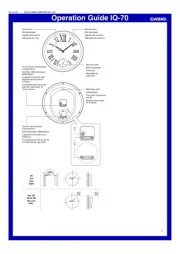
18 Juni 2025
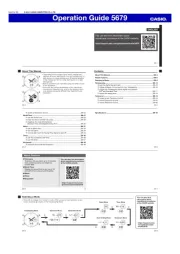
17 Juni 2025
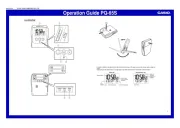
17 Juni 2025
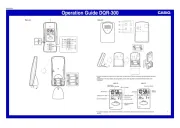
16 Juni 2025

16 Juni 2025
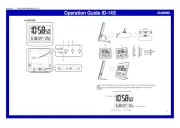
16 Juni 2025
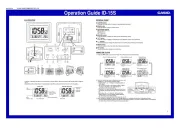
16 Juni 2025
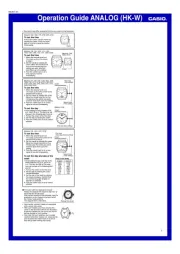
16 Juni 2025
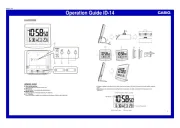
16 Juni 2025
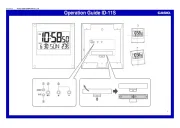
16 Juni 2025
Handleiding Horloge
- Polar
- Sekonda
- Cover
- Zeppelin
- Versace
- Lorus
- Diesel
- Westfalia
- Raketa
- Fromanteel
- Slazenger
- Sinn
- ESQ
- Timex
- Rolex
Nieuwste handleidingen voor Horloge

2 September 2025

1 September 2025

1 September 2025

1 September 2025

31 Augustus 2025

19 Augustus 2025
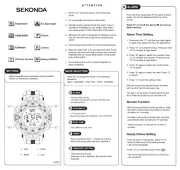
19 Augustus 2025

18 Augustus 2025

18 Augustus 2025

18 Augustus 2025